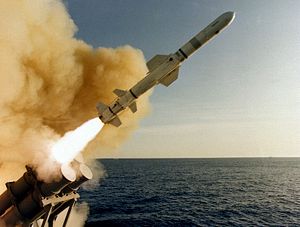Last week, Boeing Defense, Space & Security (BDS) announced that it will offer the United States Navy an updated version of the Harpoon RGM-84 Block II anti-ship missile (ASM), called Harpoon Next Generation, for the navy’s new Littoral Combat Ship (LCS) and the modified LCS Frigate program, USNI News reports.
Boeing will offer both a new missile as well as a kit to upgrade the existing Harpoon inventories of the U.S. Navy and 27 international clients. The principal improvements of the next generation Harpoon ASM, in comparison to the current model in use, will be increased range, a more fuel-efficient engine, and a smaller 300-pound class warhead.
According to Jim Brooks, director of cruise missile systems weapons programs for Boeing Global Strike Weapons and Missile Systems, a division of BDS, the upgrade aims at “doubling the range of Harpoon from 67 nm [124km] to 134 nm [248km].” The next generation Harpoon and the kit are supposed to be ready by 2018.
Since its introduction in 1977, the Harpoon missile has undergone ten upgrades. IHS Jane’s Defense Weekly reports that in the past,
concerted effort focused on the front end of the missile with improved guidance capabilities, navigation, and seeker capability. Brooks said that while Harpoon Next Generation is considered the next logical upgrade in the missile’s evolution, its improvements are focused on the back end of the system; adding more fuel, moving to a more fuel-efficient engine, and bringing in a lighter warhead to compensate for the increased fuel load.
However, USNI News notes:
The modified Harpoon will not be Boeing’s offering for the separate Next Generation Strike program which recently paired the Navy’s Offensive Anti-Surface Warfare (OASuW) Increment II and Next Generation Land Attack Weapon into a single program (…)
One of Boeing’s principal selling points will be the Harpoon missile’s low costs: “Offering up an extended range capability for Harpoon at an affordable cost has been a driving force behind the upgrade kit,” summarized IHS Jane’s Defense Weekly. “A new Next Gen would be approximately the same [cost] as for one of our Harpoons. A retrofit would be half the cost of a new missile,” notes Jim Brooks. IHS Jane’s Defense Weekly quotes the unit cost for a Harpoon Block II to be at around $1.2 million.
As I reported earlier, the U.S. Navy still lacks an adequate long-range, anti-surface weapon to implement a re-organization of the surface fleet based on the “distributed lethality” idea (see: “The US Navy’s New Surface Warfare Strategy: ‘Distributed Lethality’”). The aging anti-ship missiles currently in use — including the Boeing RGM-84 Harpoon Block II and the French-designed MBDA Exocet — no longer fulfill the operational requirements set out in the navy’s new more aggressive warfighting strategy.
Competition for new anti-ship missiles is fierce. Last week, the Norway-based Kongsberg Gruppen arms supplier and the U.S. missile manufacturer Raytheon announced a new joint-venture to convince the navy to acquire the fifth-generation over-the-horizon Kongsberg Naval Strike Missile (NSM) for its new Littoral Combats Ships (LCS) (see: “Will the US Buy the Naval Strike Missile?”).
However, Boeing bets on the large number of missiles in the U.S. Navy’s arsenals requiring upgrades. According IHS Jane’s Defense Weekly, the company has produced around 7,500 Harpoon Block II missiles for the United States Navy and other maritime powers to date. As Beth Kluba, vice-president of weapons and missile systems for Boeing Military Aircraft, notes: “It’s really looking at leveraging that installed base of existing Harpoon. That’s one of the key affordability tenets we’re offering with Harpoon Next Generation.”
































